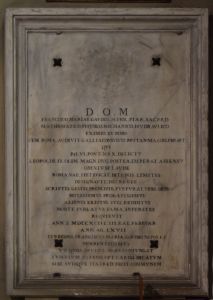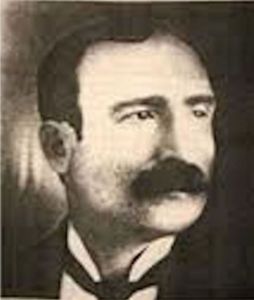Religious and Hydraulic Engineer
He was born in Sanremo on 21 February 1726 to Giovanni Battista and Maria Ferrandini, one of the greatest mathematicians in Liguria.
He completed his first studies in Sanremo demonstrating a remarkable intuitive ability and an extraordinary memory. Not being able to continue his mathematics studies in his home town, a discipline in which he felt particularly well versed, he decided willingly to join the Order of the Scolopi which would allow him, among other things, to continue his studies at the most prestigious universities and under the guidance of the most skilled and qualified teachers. At the age of twenty he moved to Rome with the aim of perfecting his studies at the Collegio Nazareno, where other fellow countrymen were already studying under the guidance of the most illustrious professors, thanks also to the use of the most sophisticated scientific instruments available at the time.
In this environment rich in cultural ferment and scientific stimuli, the young man from Sanremo was soon able to make a name for himself for his outstanding talents in the field of mathematics and physics, publishing between 1756 and 1760 four Latin dissertations, dedicated respectively to the strength and general law of nature, the nature of extension, the height of the atmosphere and the rectilinear propagation of light.
Pope Benedict XIV, informed of the extraordinary abilities of the young Matuziano, decided then to entrust him with the teaching of mathematics and rational philosophy in the university chair of the prestigious University of Wisdom, while Cardinal Casati appointed him at the same time mathematician of the "Congregation of the good governance of the waters", hence the nickname of "Roman Archimedes".
This task was particularly complex and delicate due to the considerable technical and scientific difficulties that emerged from the securing of the Tiber bed in order to preserve the vast surrounding area from the risk of flooding of the river. Gaudio demonstrated all his value in the task entrusted to him, succeeding in solving serious problems related to the management of the important watercourse, which was thus arranged in an effective and safe way for the resident population along its course. The success achieved in the arrangement of the bed of the Tiber also won him the Pope's sympathy for the dispute over the arguments he publicly supported against Aristotelian philosophy and Ptolemaic astronomy.
In the meantime he continued his more strictly scientific activity, publishing between 1762 and 1769 four works in Latin dedicated to mathematical disciplines which he was then teaching at the Capitoline University. In 1774, while he was beginning the writing of a work in Latin on the results just achieved in the arrangement of the course of the Tiber in Rome, he was commissioned to direct the work necessary to contain the damage caused by the flooding of the river at the Fratta di Perugia, where he was able to put into practice his skills in the field of technique.
hydraulic by designing innovative embankment, weir and channel diversion systems, thus solving serious problems that had discouraged many of its predecessors.
In this period he also distinguished himself in studies on the "repletion and depletion" of lakes, which shed light on a principle of hydrostatics still discussed by scientists today.
Important results were also obtained from the study on the relationship between the speed and the disposition of a river bed, while he did not hesitate to take a position also on local problems, disputing the opinion of authoritative scholars through the publication of a "limited number of hydrostatic reasons over the claims of the city of Ravenna".
In 1785 he instead carried out important studies on the composition of air, following the general chemical theory of the time according to which all combustible and oxidisable bodies contained an ethereal and imponderable substance called "phlogiston", so that the air - according to the scientific convictions of the time - would have been composed of nitrogen and oxygen. In this field the mathematician from Sanremo could therefore do nothing but follow the theory which, although wrong, was then universally accepted. The great fame achieved in these years by Gaudio is also confirmed by the task entrusted to him by Pope Pius VI and Grand Duke Leopold of Tuscany to establish the borders between the two States from Montepulciano to Chiusi. He demonstrated then such scrupulousness and precision in carrying out the task assigned to him that both sovereigns publicly congratulated him on his excellent work.
After having asked to be exempted from university teaching because of his countless commitments, he obtained a large pension and then went to Genoa, where the government of the Serenissima assigned him a flat and a substantial salary to study the currents of the port of Genoa.
In 1788 he published a "Discourse on undertow" in which he demonstrated that this last phenomenon was not the cause of the damage to the Genoese port.
The year before, he had been called to Sanremo to resolve the long-standing question of the port of call in his home town, which had been the subject, since 1770, of a series of projects aimed at its expansion and relaunch also at a commercial level.
The situation was also further complicated by the fact that, after the failure of the revolution of 1753, the Genoese authorities wanted to hinder as much as possible any attempt to revive the Matutian port.
After the presentation of two projects by the Genoese engineers Policardi and Gustavo, both rejected in 1770 and 1781 respectively, the solution for a new city port still seemed a long way off when both the Genoese government and the local authorities decided to call it Gaudio, which was well received, both as a San Remo citizen intent on guaranteeing a better future for his city and as a distinguished scholar eager to apply his theories on sea currents, the effects of undertow and the strength of sea storms.
The project he drew up, which involved the construction of a new pier to the west and the extension of the old one to avoid the risk of its silting up by the waters of the San Francesco torrent, therefore went from the study phase to the work without difficulty because even the most critical people did not dare to challenge his undisputed expertise in the field.
During the course of the works, however, problems arose because, during the construction phase of the extension of the old pier, the orientation of the latter took a completely different direction from that planned by Gaudio, who may have changed his mind perhaps influenced by the many conflicting opinions that had emerged during the course of the works or, according to others, because he was betrayed by the same Genoese government that imposed the change of direction to the workers responsible for the execution of the extension.
The only result achieved was that the new port presented the same problems as the old one because it was subject to the risk of continuous silting up and beaten by strong and dangerous gusts of wind.
Indeed, the Genoese government blamed the mistake made on Gaudio himself, as the planned works had been carried out scrupulously respecting the project prepared by the engineer from Matuzia.
The numerous criticisms made of his work by many people from Sanremo greatly afflicted the already sick scientist, who eventually died of heartbreak in Sanremo on 30th January 1793.
He was buried in the church of Santa Maria degli Angeli near the altar of San Giuseppe.  The local jurisconsult Bartolomeo Bruni then wrote a long inscription in Latin to his memory, currently located at the back of the church to the right of the main door, praising the virtues and doctrine of the illustrious scientist. His last studies, which remained unpublished, were dispersed, but his genius shone not only in the fields of hydraulics, natural sciences and mathematics, but also in architecture, painting and music.
The local jurisconsult Bartolomeo Bruni then wrote a long inscription in Latin to his memory, currently located at the back of the church to the right of the main door, praising the virtues and doctrine of the illustrious scientist. His last studies, which remained unpublished, were dispersed, but his genius shone not only in the fields of hydraulics, natural sciences and mathematics, but also in architecture, painting and music.
However, it was only many years after his death that the municipal authorities of Sanremo, having finally re-established the truth about the painful history of the port, named a street in the city centre after him, recognising his undisputed merits in the scientific and cultural field.
(source: text Andrea Gandolfo "Vite di Cittadini Illustri"; image from private archive)





